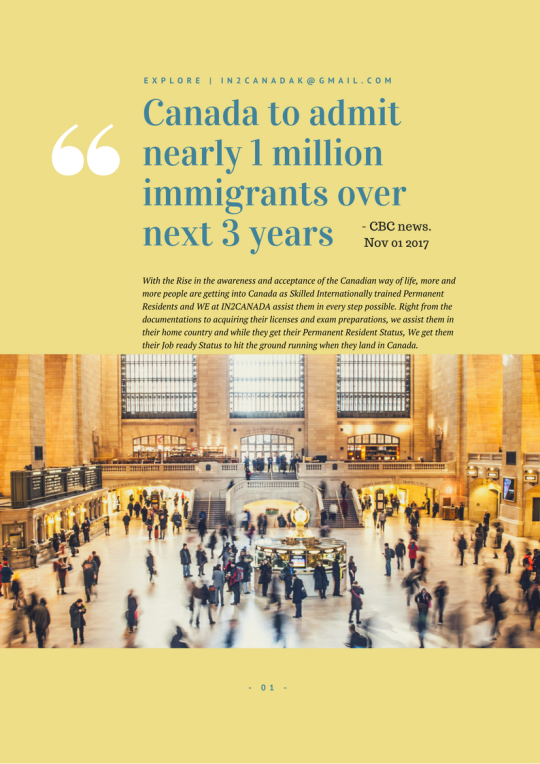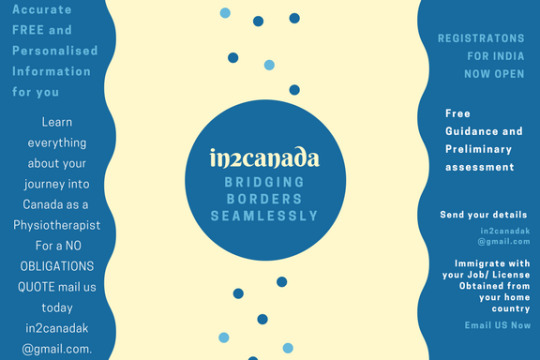Text
Breaking News Today

The country welcomed 1.2 million new #immigrants between 2011 and 2016, with 60.3 per cent of them being admitted as "economic" immigrants — nearly half of those through the skilled workers program. More than 60 per cent of new immigrants come from #Asia (including the Middle East), by far the largest source. Africa, however, has now surpassed Europe as the second-most important source of new immigrants, increasing to 13.4 per cent.
If you are thinking about living and working in #Canada, you need to know about credential recognition. Understanding how your education and work credentials are recognized will help you adapt to life and work in Canada. #Foreign credential recognition is the process of verifying that the education, training and job experience you obtained in another country are equivalent to the standards established for Canadian workers.
Here are some things you need to know:
• Qualifying to #immigrate to Canada does not mean that your education, work experience and professional credentials are automatically recognized in Canada.
• Working in some #jobs in Canada, including certain trades, may require a licence. To get a licence, you will need to have your credentials recognized.
• You can start the credential assessment and recognition process before you arrive in Canada. That is where #in2canada can start helping you take accurate and optimal decisions.
• Getting your credentials recognized takes time and costs money
Regulated occupations:
Many professions set their own standards for how the profession is practised. These are called regulated occupations. In Canada, about 20 percent of jobs are in occupations regulated by the provincial or territorial governments. Through legislation and regulations, the provinces and territories give professional organizations the authority to regulate certain professions. The role of these organizations is to protect public health and safety and to ensure that professionals meet the required standards of practice and competence. If you want to work in a regulated occupation and use a regulated title, you must have a licence or certificate or be registered with the body responsible for regulating your occupation in the province or territory where you plan to work. Some fields where regulated occupations are commonly found include:
• #health care (Physiotherapy)
• #financial services
• #law and legal services
• #engineering
Other regulated occupations include skilled trades or apprenticeable trades. Requirements for entry into a regulated occupation can vary between provinces and territories. They usually include:
• the examinations
• an #evaluation of #language and communication skills
• a specified period of supervised work experience
• the #fees
Each regulated occupation sets its own requirements for getting a licence or certificate, usually through the provincial or territorial regulatory body or professional association.
Unregulated occupations A non-regulated occupation is one you can work in without a licence, certificate or registration. Most jobs in Canada are in nonregulated occupations. Requirements for employment vary between employers. However, always be prepared to show that you have the education or experience to do the job. You will have to demonstrate a certain level of skill or competence, a specific amount of education, and even the right personal qualities and soft skills for the job. For example, the field of marketing is not regulated, but most employers will expect you to have a degree or a certificate in business and some specific training or experience in marketing. It is up to the employer to decide whether the qualifications you have earned outside Canada are equivalent to the Canadian qualifications needed for the job. Written with excerpts from Welcome To Canada Booklet and made for In2Canada.
0 notes
Photo

At In2Canada we help you set that journey that you seek, with the tools you need and the Experience we have, being already through the entire process ourselves
0 notes
Photo

Join us to help you achieve your dream of being a fully licensed Physiotherapist in Canada. For a free Assessment of your profile and to recieve a No Obligation Quote for your action plan in your quest for Canada drop us a Mail at [email protected]
0 notes
Photo

Whenever someone #dreams of going to Canada as an #immigrant there is a multi headed Serpent that bares its fangs onto the #Applicant. The major heads of the serpent being,#IELTS, Accurate filing of Documentations and the #Professional Eligibility of the Applicant.
In this 3 part series of #in2canada and #ShahSpeaks, we are going to cover a multitude of tips that will empower you to be closer to your dream.
For IELTS here are a few tips compiled for your convenience
DECIDE if you want to appear for the Academic or General and Register for the test. There are 48 test dates per year and IDP IELTS offers over 200 test locations all over the world. Search for a test centre near you and find a convenient test date. Check the IELTS score (BAND 7 for Canada) required by your chosen university, institution, employer or organisation.
PREPARE for taking an English language course is one of the best ways to improve your English. In2Canada has a wide network of exclusive, reliable and cost effective partners who can enable your successful transition to a Band & or above. The feedback you receive from the guides and the exhaustive resources will help you improve the specific skills involved in speaking, listening, reading and writing English. Test preparation is different to an English language course, as it will not help improve your English. An IELTS preparation course can help you familiarise yourself with the types of tasks included in an IELTS test. Contact in2canada for more information about a preparation course near you.
PRACTICE to Listen to English language radio, television and films. You should try to listen to a variety of English accents including American, Australian, British, Canadian and New Zealand. Read English publications such as newspapers and magazines regularly. Write letters, emails or notes in English whenever possible. Speak English with your friends and family. At in2canada we strongly believe that speaking and reading are 2 major factors that reduce your score as we take it for granted most times.
For further information you can get in touch with in2canada where we can help you connect with the most reliable and successful traning institutes that will give you a fast and lucid training that can help you reach your goal sooner than you can imagine.
0 notes
Text
Internationally Educated Physiotherapist in Canada
Written with parts from the Canadian Physiotherapy Association
In Canada, physiotherapy is a regulated profession. To work as a physiotherapist, you must register with the regulatory body in the province or territory where you work. It is illegal to practise if you are not licensed or registered. Only registered physiotherapists are eligible to use the terms “physiotherapist”, “physical therapist” and the professional designation “PT”.
The Canadian Alliance of Physiotherapy Regulators (the Alliance) evaluates educational credentials and administers exams for competency on behalf of most of the provincial and territorial regulators. Each provincial and territorial regulator may also have additional requirements before you can practise. The Alliance provides information to the regulators on credentials and qualifications, and the regulators decide who can and who cannot receive a licence to practise.
In2Canada acts as a Portal for the Internationally trained Physiotherapists to pursue their dream of working as a registered Licensed Physiotherapist in Canada.We provide guidance right from the Idea of Immigration to Credential evaluation, Documentation,Canadian examinations Preparations ( Classes happening in Canada and India in Real time and in person), Registration assistance with Provinces and Setting up connections to Job placement agencies.
Becoming a registered physiotherapist in Canada
There are a number of steps to becoming a registered physiotherapist in Canada:
You need to decide where you want to work.
Then, check the requirements you need to meet to work there by contacting the regulator, In2Canada helps you with guidance on selecting the province based on your aptitude and attitude.
For most regulators, you must complete The Alliance’s Educational Credentials and Qualifications Assessment. You can begin this before you come to Canada. That's where In2Canada assists you to get the paperwork right in the first attempt and hence save time, money and energy on that process.
This assessment ensures that your education and qualifications are similar to the education and qualifications of a Canadian-educated physiotherapist.
You will need to prove your language skills or take a language test. All of the above things can be done from India with assistance and guidance from In2 Canada
0 notes